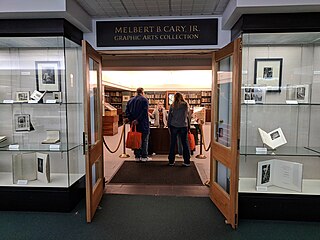TeX, stylized within the system as TeX, is a typesetting system which was designed and written by computer scientist and Stanford University professor Donald Knuth and first released in 1978. TeX is a popular means of typesetting complex mathematical formulae; it has been noted as one of the most sophisticated digital typographical systems.

Hermann Zapf was a German type designer and calligrapher who lived in Darmstadt, Germany. He was married to the calligrapher and typeface designer Gudrun Zapf-von Hesse. Typefaces he designed include Palatino, Optima, and Zapfino. He is considered one of the greatest type designers of all time.

In typography, a dingbat is an ornament, specifically, a glyph used in typesetting, often employed to create box frames, or as a dinkus. Some of the dingbat symbols have been used as signature marks or used in bookbinding to order sections.

Frederic William Goudy was an American printer, artist and type designer whose typefaces include Copperplate Gothic, Goudy Old Style and Kennerley. He was one of the most prolific of American type designers and his self-named type continues to be one of the most popular in America.
In digital typography, Lucida Sans Unicode OpenType font from the design studio of Bigelow & Holmes is designed to support the most commonly used characters defined in version 1.0 of the Unicode standard. It is a sans-serif variant of the Lucida font family and supports Latin, Greek, Cyrillic and Hebrew scripts, as well as all the letters used in the International Phonetic Alphabet.
Wingdings is a series of dingbat fonts that render letters as a variety of symbols. They were originally developed in 1990 by Microsoft by combining glyphs from Lucida Icons, Arrows, and Stars licensed from Charles Bigelow and Kris Holmes. Certain versions of the font's copyright string include attribution to Type Solutions, Inc., the maker of a tool used to hint the font.

Computer Modern is the original family of typefaces used by the typesetting program TeX. It was created by Donald Knuth with his Metafont program, and was most recently updated in 1992. Computer Modern, or variants of it, remains very widely used in scientific publishing, especially in disciplines that make frequent use of mathematical notation.

Luxi is a family of typefaces originally designed for the X Window System by Kris Holmes and Charles Bigelow from Bigelow & Holmes Inc. The Luxi typefaces are similar to Lucida – their previous font design.

Lucida is an extended family of related typefaces designed by Charles Bigelow and Kris Holmes and released from 1984 onwards. The family is intended to be extremely legible when printed at small size or displayed on a low-resolution display – hence the name, from 'lucid'.

Webdings is a TrueType dingbat typeface developed in 1997. It was initially distributed with Internet Explorer 4.0, then as part of Core fonts for the Web, and is included in all versions of Microsoft Windows since Windows 98. All of the pictographic Webding glyphs that are not unifiable with existing Unicode characters were added to the Unicode Standard when version 7.0 was released in June 2014.

Lucida Grande is a humanist sans-serif typeface. It is a member of the Lucida family of typefaces designed by Charles Bigelow and Kris Holmes. It is best known for its implementation throughout the macOS user interface from 1999 to 2014, as well as in other Apple software like Safari for Windows. As of OS X Yosemite, the system font was changed from Lucida Grande to Helvetica Neue. In OS X El Capitan the system font changed again, this time to San Francisco.

Zapfino is a calligraphic typeface designed for Linotype by typeface designer Hermann Zapf in 1998. It is based on an alphabet Zapf originally penned in 1944. As a font, it makes extensive use of ligatures and character variations.

Kris Holmes is an American typeface designer, calligrapher, type design educator and animator. She, with Charles Bigelow, is the co-creator of the Lucida and Wingdings font families, among many other typeface designs. She is President of Bigelow & Holmes Inc., a typeface design studio.

Carol Twombly is an American designer, best known for her type design. She worked as a type designer at Adobe Systems from 1988 through 1999, during which time she designed, or contributed to the design of, many typefaces, including Trajan, Myriad and Adobe Caslon.

New York is a transitional serif typeface designed in 1983 for the Macintosh computer by Susan Kare and reworked in 1988 by Charles Bigelow and Kris Holmes. The typeface was the standard bitmap serif font for the early Macintosh operating systems. Originally titled “Ardmore”, it was renamed to New York before its initial release as part of the "World Class Cities" naming scheme by Apple Computer cofounder Steve Jobs.
Ascender Corporation was a digital typeface foundry and software development company in the Chicago suburb of Elk Grove Village, Illinois. It was founded in 2004 by a team of software developers, typographers, and people previously involved in developing fonts used widely in computers, inkjet printers, phones, and other digital technology devices. On December 8, 2010, Ascender Corp. was acquired by Monotype Imaging.
The Frederic W. Goudy Award & Lecture were established in 1969 by funds donated to Rochester Institute of Technology (RIT) by the Mary Flagler Cary Charitable Trust in memory of her late husband, Melbert B. Cary, Jr., a typographer, type importer, fine printer, book collector, and president of AIGA. The award was named after illustrious American type designer Frederic W. Goudy, a friend and business associate of Melbert Cary.

The Cary Graphic Arts Collection is a library and archive of books, type specimens, manuscripts, documents, and artifacts related to the history of graphical communication. Located in Wallace Library at the Rochester Institute of Technology (RIT), in Henrietta, New York, the Cary Collection contains literate artifacts as old as cuneiform tablets and as recent as computer tablets and e-books, in all comprising some 40,000 volumes in addition to manuscripts, correspondence, printing types and traditional letterpress printing equipment.













